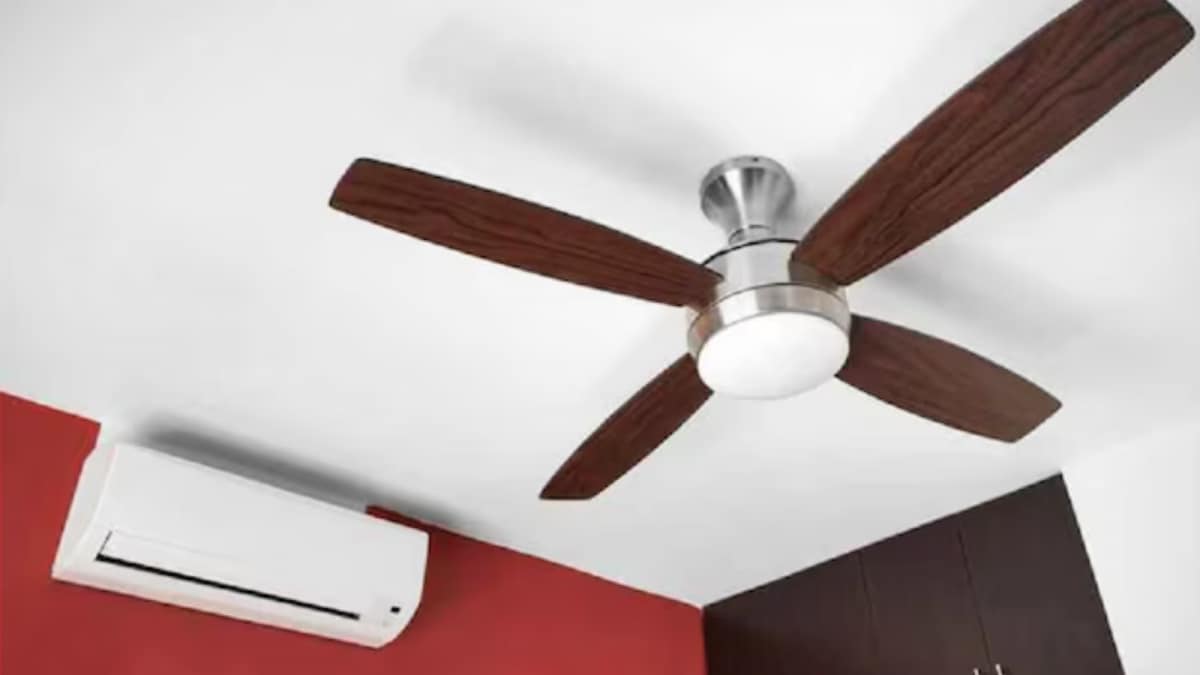Last Updated:
Choosing an energy-efficient fan today means significantly lower bills and reduced energy consumption for the next decade or more.

The Bureau of Energy Efficiency (BEE) now mandates star ratings, with a 1-star fan consuming around 50–55W.
Authored By Pramod Kumar Singh & Rohan Kadamb:
While a conventional fan may seem cheaper upfront, its higher energy consumption leads to costs more than double that of a 5-star rated energy-efficient fan over its lifespan. Choosing an energy-efficient fan today means significantly lower bills and reduced energy consumption for the next decade or more.
The Unseen Energy Drain Above Our Heads
Look up in almost any Indian home, office, or shop, and you’ll likely see a ceiling fan spinning quietly. It’s an appliance so common, so essential for comfort in our climate, that we barely notice it. Ceiling fans are ubiquitous, found in nearly 90% of Indian households, according to the National Family Health Survey. With 40 to 60 million new fans sold each year, they are one of the most purchased appliances in the country.
This near-universal presence, combined with long operating hours – often 12 hours a day or more – means ceiling fans collectively consume a staggering amount of electricity, estimated at 20% to 40% of total residential power use (PIB Article, 2023). While an individual fan uses less power than an air conditioner, their sheer numbers mean their total annual energy consumption rivals that of ACs. As temperatures rise and India’s need for cooling grows, addressing the efficiency of this everyday appliance is no longer just desirable – it’s urgent.
The Illusion of Savings – Unmasking the True Cost of Inefficient Fans
For decades, the standard ceiling fan used a simple induction motor, consuming around 70–80 watts (W) of power. While newer regulations have improved minimum standards, most fans sold today still use significant energy. The Bureau of Energy Efficiency (BEE) now mandates star ratings, with a 1-star fan consuming around 50–55W.
However, the real game-changer is the 5-star rated fan, typically using advanced Brushless DC (BLDC) motor technology, which slashes energy use down to just 28–35W – a saving of over 50% compared to conventional models.
Many consumers are drawn to older, less efficient fans because of their lower purchase price. A conventional fan might cost under Rs 1,500, while a basic 1-star fan is around Rs 1,250–2,200, and a 5-star BLDC fan starts around Rs 2,500-3,500. This initial saving, however, is a costly illusion. Over the typical 10–15 year lifespan of a fan, the higher electricity consumption of an inefficient model dwarfs the upfront price difference.
Consider this simplified 10-year lifecycle cost comparison, assuming 12 hours daily use for 250 days a year (3,000 hours) and an average electricity tariff of Rs 8/kWh:
| Fan Type | Avg. Power (W) | Avg. Purchase Price (INR) | Annual Energy Use (kWh) | Annual Electricity Cost (INR) | 10-Year Electricity Cost (INR) | Total Lifecycle Cost (INR) |
|---|---|---|---|---|---|---|
| 0-Star | 75 | 1,200 | 225 | 1,800 | 18,000 | 19,200 |
| 1-Star | 50 | 1,400 | 150 | 1,200 | 12,000 | 13,400 |
| 5-Star | 28 | 2,500 | 84 | 672 | 6,720 | 9,220 |
(Note: Prices and tariffs are indicative averages; actual costs vary.)
As the analysis shows, the 5-star fan, despite its higher initial cost, is significantly cheaper over its lifetime. The conventional fan ends up costing more than double. Because fans last so long, buying an inefficient one today locks in these higher energy costs and wasted energy for more than a decade, as people rarely replace fans unless they break.
The Efficiency Revolution: A Market-Ready, Yet Untapped
Recognising the potential, the government took a crucial step by making BEE star labelling mandatory for all ceiling fans from January 2023 (BEE, 2023). This policy aims to push the market towards better efficiency by encouraging manufacturers to produce energy-efficient ceiling fans, while providing consumers with clear information through star labels to make informed choices.
The industry has responded impressively. Numerous manufacturers, both large established players and newer entrants, now offer a wide array of energy-efficient fans, particularly 5-star BLDC models. These BLDC fans often come with added benefits like remote controls, quieter operation, and longer lifespans. Prices, while still a barrier, have been falling and are expected to decrease further as production and market adoption scale up.
Despite this progress, a paradox remains: the actual adoption of energy-efficient fans in Indian homes is incredibly low, estimated at a mere 3–5% of the total installed base (CEEW, 2022). The primary hurdles remain the higher upfront cost and lack of widespread consumer awareness about the long-term savings, especially outside major urban centres. Mandatory labelling is essential, but it alone cannot overcome these barriers for a long-lasting appliance where initial cost heavily influences purchase decisions.
Smarter Spending – Why Subsidising Fans Beats Subsidising Bills
Currently, state governments spend vast sums on electricity subsidies – over Rs 1.1 lakh crore in direct subsidies in FY-2023 (IISD, 2023), plus an estimated Rs 75,000 crore in cross-subsidies (IISD, 2023). Although well-intentioned, broad consumption subsidies can, without precise targeting, weaken consumers’ incentives to conserve energy and may inadvertently encourage less efficient usage patterns.
There is a smarter way. Instead of subsidising every unit of electricity consumed indefinitely, policymakers should focus on providing upfront capital subsidies for the purchase of highly efficient BEE 5-star rated ceiling fans. This approach offers multiple advantages: it directly tackles the upfront cost barrier, making efficient technology accessible; it permanently reduces household electricity demand and bills for the fan’s lifetime, saving consumers thousands of rupees; it lowers the strain on the electricity grid, with an estimated potential to reduce peak demand by 14 GW (CEEW estimate), especially during peak summer months; and, crucially, it reduces the long-term need for electricity price subsidies, potentially saving significant government expenditure.
Shifting support from subsidising energy consumption to subsidising energy efficiency is a strategic investment that benefits consumers, DISCOMs, energy security, and climate goals simultaneously.
Let’s Switch on the Savings!
The path to a cooler, more energy-secure India requires smart choices, both at home and in policy.
It’s time for policymakers to shift the focus. Implement and scale up targeted capital subsidy programmes for BEE 5-star ceiling fans, learning from past initiatives to ensure effective delivery. Support this with robust awareness campaigns educating citizens on lifecycle costs and the benefits of star ratings. Concurrently, begin reforming existing electricity subsidies to improve targeting and free up fiscal resources for efficiency investments.
Meanwhile, when buying a fan, consumers need to start looking beyond the initial price tag. Check the BEE star label – choosing a 5-star fan is an investment that pays back handsomely through lower electricity bills year after year. Ask retailers for efficient models and let your choice drive the market.
The humble ceiling fan represents a massive, untapped opportunity for energy savings across India. By embracing efficiency and supporting it with smart policy, we can cool our homes affordably, strengthen our energy system, and take a significant step towards a sustainable future.
(Pramod Kumar Singh is senior director, and Rohan Kadamb is research associate at the Alliance for an Energy Efficient Economy)
A team of writers and reporters decodes vast terms of personal finance and making money matters simpler for you. From latest initial public offerings (IPOs) in the market to best investment options, we cover al…Read More
A team of writers and reporters decodes vast terms of personal finance and making money matters simpler for you. From latest initial public offerings (IPOs) in the market to best investment options, we cover al… Read More
September 24, 2025, 16:25 IST
Read More







